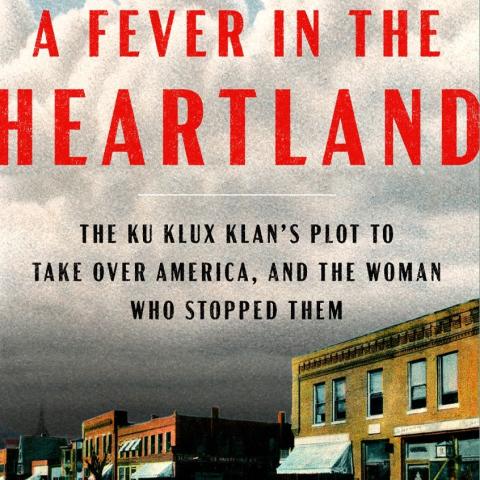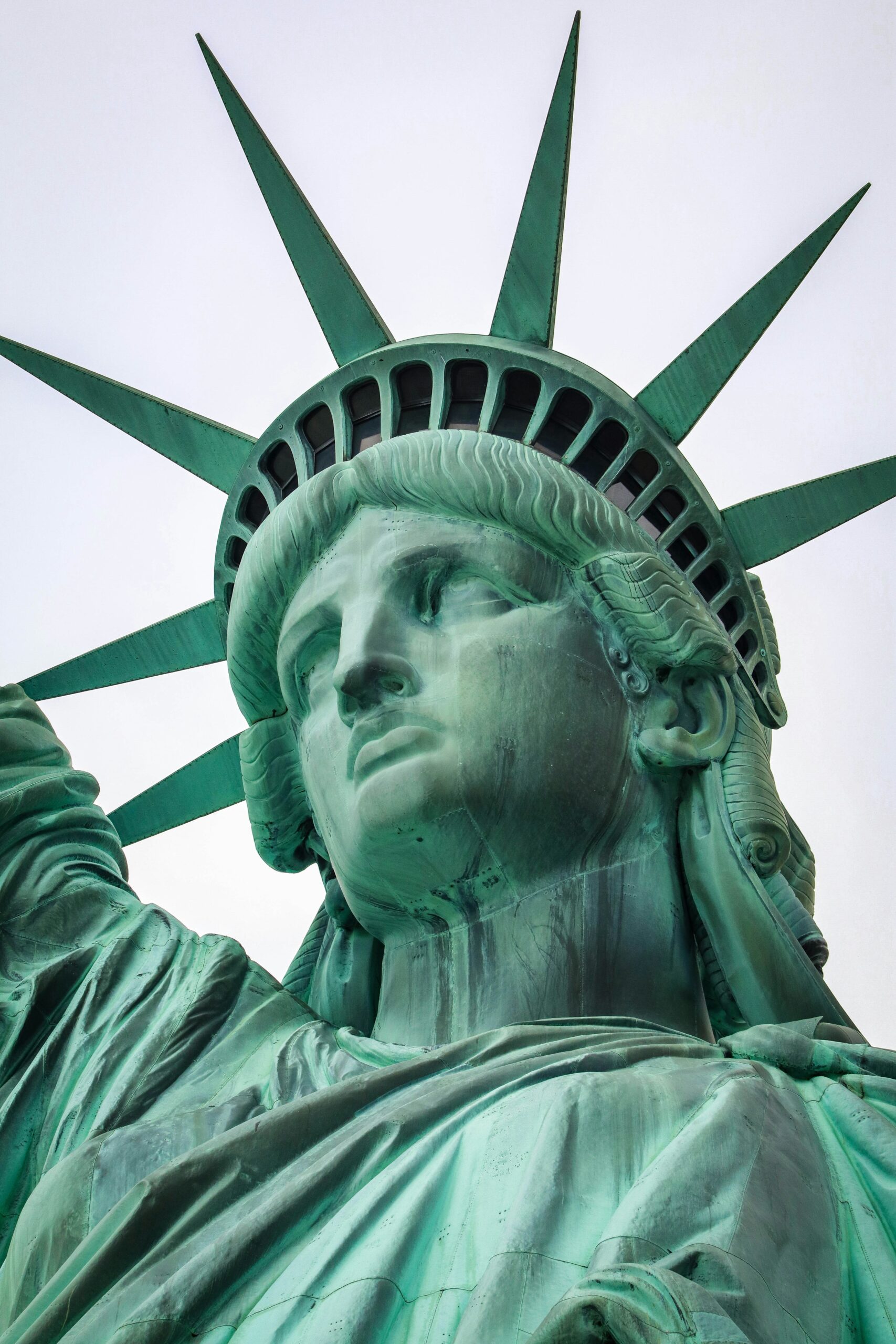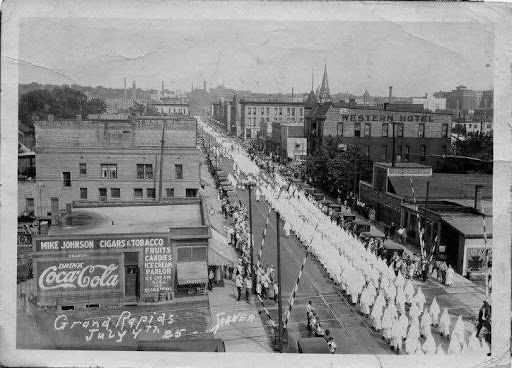
I’ll be upfront: I’m not a scholar or an expert. I am an observer and political activist who connects the dots in this messy world of politics and faith. There are troubling connections between today’s Christian Nationalism and the 1920’s Ku Klux Klan—and we need to name it.
I recently read A Fever in the Heartland by Timothy Egan. It describes how in the 1920s the KKK re-emerged from its violent past by promoting “American” and “Christian” values. This book helped me connect some noteworthy dots to today’s Christian Nationalism.
A Conversation That Stuck with Me
Not long ago, I had a conversation with a relative—an evangelical Catholic. She’s devoted to the Church’s history and traditions, but she has a blind spot concerning Catholic Social Teaching and its emphasis on care for the poor and vulnerable.

As we bantered about immigration, she stated that the U.S. should prioritize admission of Christian immigrants, and if we do accept non-Christians, they shouldn’t have the same civil rights as Christians. She reasoned that since America is a “Christian nation,” our laws and policies should reflect Christian values and discriminate against “non-Christian influences.”
It seems as if she’d never heard Lady Liberty’s words, “Give me your tired, your poor, your huddled masses yearning to breathe free, the wretched refuse of your teeming shore. Send these, the homeless, tempest-tossed to me. . .” My relative stated that some people deserve more rights and freedoms than others simply because they say they love Jesus.
That’s exclusion.
This “othering” of non-Christians, this exclusive, prejudicial treatment, is the seed of hate. If we are to take seriously the Parable of the Wedding Feast (Matthew 22:1–14), we understand this is not the message of an inclusive Jesus.
The Klan’s “Family Values” Makeover

A Fever in the Heartland helped me realize that this belief isn’t new. In the 1920s, after being outlawed for its violent terrorism in the late 1800s, the KKK made a comeback through rebranding. Instead of leading with violence, they played the “values.” card. They stood for virtue — protecting women, promoting racial and sexual purity, defending traditional marriage, and being “patriots.”
Sound familiar? It should.
The Klan of the 1920s talked a lot about Christian virtues, but their message wasn’t about faith. It was about drawing lines: who’s in and who’s out. Catholics, Jews, Blacks, and non-Aryan immigrants were on the outside as threats to America’s mythical “Christian Heritage.”

By promoting a version of Christianity that excluded anyone who didn’t fit, they laid the groundwork for discrimination, oppression, intimidation, and violence. Many churches got on board with their message, framing it as virtuous and righteous, while others remained silent.
The Echoes I See Today

Similar patterns exist in today’s Christian Nationalism. “History doesn’t repeat itself, it rhymes,” a quote often attributed to Mark Twain, fits here. The priorities of Christian Nationalism rhyme with the earlier KKK message. Who counts and who doesn’t? Who gets full citizenship and full belonging and who doesn’t? Who is entitled to due process and who isn’t? Who is an outsider and who isn’t?
The agenda shows up in governmental actions: gutting the Voting Rights Act and enacting voter suppression, limiting immigration from non-white and non-Christian countries, and focusing on rooting out so-called bias against Christians while excluding protections for non-Christian religious groups. By affording rights and privileges to Christians that they deny to others, Christian Nationalists are anti-democratic and un-American. It is not Christian.
Exclusion Is Still Hate
It’s easy to think of hate as overt when it is expressed in racial slurs, cross burning, and lynching. But hate can also be covert, expressed in laws that restrict voting, that deny immigrants driving licenses, forbid their children access to education, and block labor protections. This hateful lens states that some folks deserve fewer rights just because of who they are or what they believe.

That’s the hate the Klan promoted in the 1920s, and it’s the hate hiding under the surface of Christian Nationalism today. Both movements use faith and morality as cover for exclusion. Both wrap hate and discrimination in the language of “virtue” and in the melodies of religious music.
Why This Matters
We are at a dangerous crossroads. When faith gets tied up with national identity and national security —especially in a way that says, “only people like us belong,” fear makes it easy to justify policies and actions that push people out.

We’ve seen it before. And we’re seeing it again — hatred wrapped in the veneer of faith and flag.
We must name hate whenever we see it, because if we only call something hateful when it turns violent, we’re missing how hate works before it ever throws a punch.
Statue of Liberty photo by Brandon Mowinkel on Unsplash


14 Responses
Well said!
Thank you for this, Dave. It’s sobering to recognize how easily hatred can disguise itself in the language of virtue and how fear and prejudice, especially racial bias, become the ribbon that ties the whole package together.
A discerning and sobering analysis. How ironic that yesterday’s white supremacists despised Catholics, but the are leading the charge against inclusive democracy today. (Their new head, Pope Bob, is pushing back and defending Gospel values, thank God, though we are waiting to see whether he still holds to the rigid view of same-sex union he voiced in the past.)
Your thoughts couldn’t be more timely. In the midst of reading “The Blood of Emmett Till” by Timothy B. Tyson, which details not only the crime, but the intimidation, murder, and voter suppression that was happening in Mississippi as well as other southern states, I had a conversation yesterday with a friend about deportations that are happening now. When I pointed out that they were mostly non-white, this friend bristled at that charactization as being exagerated. In addition, having grown up in Spring Lake, I know that, although blacks worked in our leather factory, they were quietly prevented from living in the Tri-Cities. They were relegated to Muskegon and Muskegon Heights. That was systemic racism in an area that is awash in churches of all faiths. Now we have normalization of that hatred, with televised laying on of hands by ‘spiritual leaders’ and glorified by the faithful. Lord have mercy if we don’t have eyes to see.
This essay slanders people who don’t agree with the author’s politics.
Will anyone in the Reformed Journal community speak against this?
No, we’ll leave it to you, Marty.
Dave, I agree with you. I read that book about two years ago and was taken back by the racism in the northern part of the US where I live. It was shocking to me and to other readers when you read of out-and-out hatred for Blacks, Jews, Catholics and immigrants. I grew up as a Catholic and love many people contained in their hatred. I grew up in New Jersey and my parents in New York. There were signs up in NY City that said that “Blacks and Catholics need not apply” for the jobs that were advertised. While I am no longer a Catholic, I do love the people and their beliefs and see them as fellow Christians. I also have 16 grandchildren and 8 of them are part Black/part white or all Black. I guess being one of the discriminated people makes your heart soft for others who are too.
Scary facts.
Greetings to my old friend David!
David, with due appreciation, may I ask whether there is not perhaps one thing in this posting that might pose the “slander” question that Marty Wondaal poses?
In your posting I am struck by the juxtaposition of two pictures. There is a picture of a horrendously long line of KKK marchers in Grand Rapids. Right before it, on the same screen, I see a picture of three women hold up signs pleading: “Women’s sports are for women.” At some level, it seems clear, they are being put in the same category–though what that category is left unstated. But might not we need sustained discussion, in the RJ, about what it says about ourselves, that we can do this?
Such a discussion would need to be preceded by discussion of the fairness-issue these three women are pleading with us to face. That discussion might start with a close look at the scientific evidence that is relevant to the issues of justice and fairness. On this a good start would be the thoughtful BBC report “Transgender Athletes What do the Scientists Say?” at https://www.bbc.com/sport/61346517. If we could bring ourselves look at the relevant science, we’d be in a position to weigh the questions of fairness/justice the three women are pleading us to consider. The BBC report gives a good start on this, too.
After all that, we might be in a position to consider: What did it say about us, that we juxtaposed those two pictures, suggesting that at some level they fall in the same category?
This might even shed light on why a recent election did not go the way we may have hoped.
A valid point….
That photo was inserted by the editors…
Good review and thanks for posting the pictures, especially the one on Grand Rapids. I reviewed the book last month and told about a Klan rally in Hastings MI. You can find my review here: https://fromarockyhillside.com/2025/05/01/reviews-of-my-april-readings/
Spot on. Sadly! The picture of Klansmen backed by Jesus Saves reminds me of the pictures of the cross and swastika intertwined in German Christian churches. Horrifying.
I find a valid argument made for calling out “Christian” nationalism and how it has been used in the past to WRONGLY persecute and injure other peoples. I also agree that in this present climate, many seem to be putting their love of country above their love for Jesus and our calling as Christians. However, we need to be careful not to broad brush things, else we tend to lose credibility. I see many, many being FUELED by rhetoric on both sides of the aisle, Left and Right. I see that in your article. I almost feel like I’m reading a piece from someone on the Left who is not a Christian. The thing is this: our country has laws. God is a God of law and order. When we see in the OT God encouraging outsiders being allowed to come into Israel to join them, it pertains to those who desire to ALIGN with Israel’s way of life. It does NOT pertain to those who sneak into Israel and then work to dismantle Israel’s way of life/laws, etc.
Yes, we have always been a country that has welcomed immigrants. We still are. We are a country of immigrants. In order to protect our country and know who is desiring to be a part of our country, laws have been codified. As Christians, we should encourage laws to be followed, not encourage lawlessness. As people of faith, we should encourage things to be done the correct way because we know, when done the wrong ways, many times there are uncomfortable repercussions. We are now seeing that with the ejection of immigrants who came and stayed illegally for years. If they would have come the legal route, having their lives turned upside down would not be an issue. Then there is the issue of “multiculturalism”. Some tout that as a good thing. Unfortunately, this is not true. It can be a horrific problem. We see this all over Europe now. The clash of cultures and loss of “national” identity/values/jobs. Lawlessness/crime is rampant because the culture of people who immigrated did not value the country’s laws they immigrated into. Multiple ethnicities/races is a wonderful thing, but it is not such a wonderful thing when people have very different value systems (which we are now experiencing in our own country. This is in contrast to the past where there were “points” of difference (even leading to civil war), but not a huge gulf in our overall value system as a people and application of our laws. It seems to me that there is a growing force within the US now that is encouraging lawlessness, and some of that is being presented as “Christian compassion”. Yes, Jesus loved the sinner (yet while they(we) WERE sinners), but Jesus never encouraged lawlessness, He called people to repent and be changed by Him.
As for the point on voting rights: after what we witnessed happening in 2020 with Republican inspectors being ejected, windows being covered up in the counting centers, ballots being dropped off the next day after the election, the counting taking weeks, thousands of affidavits taken by poll workers as to nefarious things going on, it appears to me that people SHOULD want to be assured that our elections are secured. Making laws such as : ID requirements (which are required for travel, banking, etc), same day in person voting (with exceptions for absentee ballots for those who cannot show up in person), hand counts to ensure no shenanigans with machines (like many other countries, like France, do). I am quite perplexed why there are some who believe protective measures like these are viewed as an assault to voting rights or are suppressing votes. Mass mail in voting is ripe for fraud, as are using the HUGE counting centers vs local precincts counting their own votes (I worked at the TCF center in Detroit in the 2022 mid terms).
PS. Lest you think I am “anti-immigrant”, both of my children married foreigners who are in the process of getting their green cards. My son in law and daughter in law both believe in doing things the right way, legally, and are frustrated because the ones doing things illegally have made it much harder and longer a process for those who are doing things the right way. I agree.